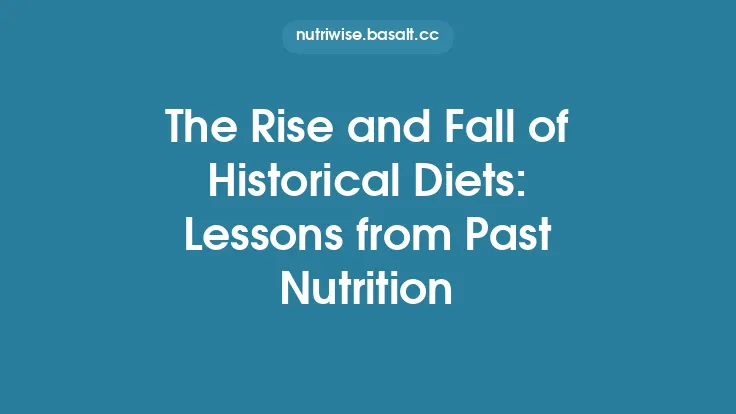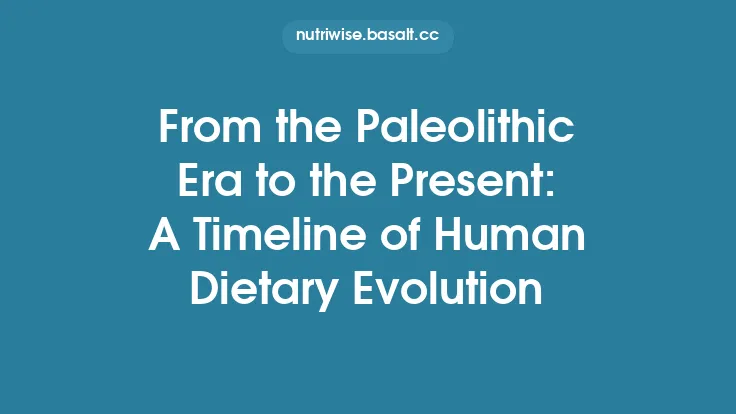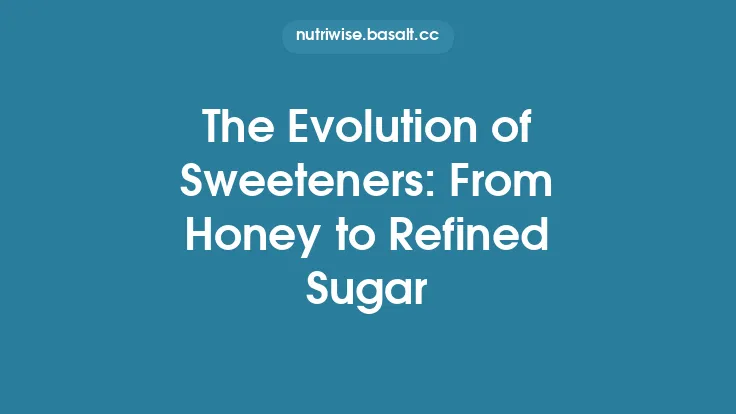The story of dairy is a tale of continual reinvention, shaped by human ingenuity, cultural preferences, and scientific breakthroughs. From the earliest experiments with naturally soured milk to today’s laboratory‑grown “milk” that never touches a cow, dairy has evolved in tandem with the societies that consume it. This evolution reflects not only changes in taste and technology but also deeper shifts in health awareness, environmental stewardship, and global connectivity. By tracing the milestones of dairy’s transformation, we can appreciate how a simple nutrient‑rich fluid became a versatile platform for culinary creativity, nutrition science, and sustainable innovation.
Early Fermented Milk in Antiquity
Fermentation is the oldest method humans used to preserve perishable foods, and milk was no exception. Archaeological evidence from the Neolithic Near East (circa 9,000–7,000 BCE) shows residues of lactic acid bacteria in pottery shards, indicating that early agrarian communities deliberately allowed milk to sour. The resulting product—often a thin, yogurt‑like beverage—had several advantages:
- Extended Shelf Life: The drop in pH inhibited spoilage microbes, allowing milk to be stored for days rather than hours.
- Improved Digestibility: Fermentation partially hydrolyzes lactose and denatures whey proteins, making the drink more tolerable for individuals with limited lactase activity.
- Nutrient Enrichment: Probiotic bacteria synthesize B‑vitamins (e.g., B12, folate) and bioactive peptides that can enhance mineral absorption.
These early fermented milks spread rapidly across the Fertile Crescent, the Balkans, and the Indian subcontinent, each region developing its own terminology—*labneh in the Levant, dahi in South Asia, kumis* among the nomadic steppe peoples. The cultural significance of these drinks often extended beyond nutrition; they featured in rituals, hospitality customs, and medicinal practices.
The Rise of Cheese and Yogurt Across Civilizations
While liquid fermented milk offered immediate benefits, the next major leap was the intentional coagulation of milk proteins to create solid curds—cheese. The earliest cheese‑making evidence dates to 7,200 BCE in what is now Poland, where milk residues on stone tools suggest curd formation. By the Bronze Age, cheese production was well established throughout the Mediterranean, the Near East, and Central Asia.
Key technological milestones include:
- Rennet Discovery: The use of animal stomach enzymes (chymosin) to cleave κ‑casein, producing a clean, firm curd. This method enabled the creation of hard, aged cheeses that could be stored for months.
- Salt Brining: Adding salt not only flavored cheese but also acted as a preservative by drawing out moisture and inhibiting undesirable microbes.
- Aging (Affinage): Controlled temperature and humidity environments allowed enzymatic and microbial ripening, developing complex flavors and textures.
Yogurt, a semi‑solid fermented milk, followed a parallel trajectory. The practice likely originated in the Anatolian highlands, where the combination of warm climates and herding cultures favored the use of thermophilic bacteria (*Lactobacillus bulgaricus and Streptococcus thermophilus*). Yogurt’s thickened consistency made it a convenient, portable source of protein and calcium, and its probiotic properties were recognized in traditional medicine systems such as Ayurveda and Unani.
Industrialization and the Standardization of Milk
The 19th century ushered in a paradigm shift: milk moved from a locally produced, seasonal commodity to a mass‑produced, year‑round staple. Several interlocking developments made this possible:
- Railway Networks: Rapid transport reduced spoilage, allowing dairy farms to supply urban centers.
- Mechanical Milking Machines: Introduced in the 1870s, these devices increased herd productivity and standardized milking hygiene.
- Refrigeration: Ice‑box technology and later mechanical refrigeration kept milk at temperatures below 4 °C, dramatically extending its shelf life.
These innovations required a new regulatory framework. Governments instituted milk inspection programs, establishing quality standards for fat content, bacterial counts, and adulteration. The result was a homogenized (pun intended) product that could be reliably marketed across regions, laying the groundwork for the modern dairy industry.
Scientific Advances: Pasteurization, Homogenization, and Fortification
The turn of the 20th century saw the application of microbiology to dairy safety and nutrition.
- Pasteurization: Developed by Louis Pasteur in the 1860s, this heat‑treatment (typically 72 °C for 15 seconds) destroys pathogenic bacteria while preserving most nutritional qualities. Pasteurization became mandatory in many countries after outbreaks of *Brucella and Mycobacterium* linked to raw milk.
- Homogenization: Invented in 1901, this high‑pressure process breaks down fat globules to ≤ 5 µm, preventing cream separation and creating a uniform texture. Homogenization also influences the rate of lipid digestion, subtly affecting satiety signals.
- Fortification: In the 1930s, vitamin D was added to milk to combat rickets, a widespread bone disease. Later, calcium, vitamin A, and omega‑3 fatty acids were incorporated, turning milk into a vehicle for public‑health nutrition interventions.
These scientific interventions transformed milk from a perishable, variable product into a predictable, fortified staple, reinforcing its role in national dietary guidelines.
Cultural Shifts and Lactose Intolerance
Despite the ubiquity of dairy in many Western diets, a substantial portion of the global population—estimated at 65 %—exhibits lactase non‑persistence, the inability to digest lactose beyond early childhood. Historically, societies with high rates of lactose intolerance (e.g., East Asia, Sub‑Saharan Africa) relied less on fresh milk and more on fermented derivatives, where bacterial lactase pre‑digests lactose.
In the late 20th century, rising awareness of lactose intolerance and dairy‑related allergies prompted cultural adaptations:
- Lactose‑Reduced Milk: Enzymatic treatment with lactase before packaging creates a product with < 0.5 g lactose per 100 mL, catering to sensitive consumers.
- Cultural Reinterpretation: Traditional cuisines began incorporating dairy alternatives (e.g., soy‑based *soymilk* in Chinese desserts) while preserving heritage flavors.
These shifts illustrate how cultural preferences and physiological diversity drive innovation within the dairy sector.
The Advent of Plant‑Based Milk Alternatives
The modern plant‑based milk market exploded in the early 2000s, propelled by health, ethical, and environmental motivations. The most prominent alternatives include:
| Plant Source | Typical Protein (g/250 mL) | Fat Profile | Notable Micronutrients |
|---|---|---|---|
| Soy | 7–9 | Moderate (unsaturated) | Isoflavones, calcium (fortified) |
| Almond | 1–2 | Low (mostly monounsaturated) | Vitamin E, calcium (fortified) |
| Oat | 2–4 | Higher carbohydrate, beta‑glucan | Fiber, B‑vitamins (fortified) |
| Pea | 6–8 | Balanced | Iron, calcium (fortified) |
| Rice | 0.5–1 | High carbohydrate | Minimal protein, fortified nutrients |
Key technological steps that enabled these alternatives to mimic dairy’s sensory properties include:
- Emulsification: Using lecithin or plant‑derived gums to stabilize oil‑in‑water emulsions, achieving a creamy mouthfeel.
- Enzymatic Hydrolysis: Breaking down plant proteins to improve solubility and reduce beany flavors.
- Fortification: Adding calcium carbonate, vitamin D₃ (or vegan D₂), and B‑12 to align nutritional profiles with cow’s milk.
Beyond nutrition, plant‑based milks have reshaped culinary practices, becoming staples in coffee culture, baking, and dairy‑free desserts.
Fermentation of Non‑Dairy Milks: New Probiotic Frontiers
The convergence of two historic trends—fermented dairy and plant‑based milks—has given rise to a new category: fermented non‑dairy yogurts and kefirs. By inoculating soy, almond, or oat milks with traditional starter cultures (*Lactobacillus, Bifidobacterium) or novel strains (e.g., Lactobacillus plantarum* isolated from fermented vegetables), manufacturers achieve:
- Acid Development: Lowering pH to 4.0–4.5, creating a tangy flavor and thickened texture.
- Probiotic Viability: Maintaining ≥ 10⁶ CFU/g at the end of shelf life, delivering health‑promoting microbes.
- Enhanced Nutrient Bioavailability: Fermentation can increase the digestibility of plant proteins and release bound minerals (e.g., calcium from soy isoflavones).
Research indicates that fermented plant milks may confer similar gut‑health benefits to traditional yogurt, while also offering lower saturated fat and allergen profiles. This hybridization exemplifies how ancient techniques can be repurposed for modern dietary landscapes.
Cellular Agriculture and Lab‑Grown Dairy
Perhaps the most radical departure from conventional dairy is cellular agriculture—producing milk proteins directly from cultured animal cells. The process involves:
- Cell Line Selection: Isolating mammary epithelial cells capable of secreting casein and whey proteins.
- Bioreactor Cultivation: Providing a nutrient‑rich medium (amino acids, sugars, growth factors) under controlled temperature, pH, and oxygen levels.
- Protein Harvesting & Formulation: Extracting secreted proteins, then blending them with plant‑derived fats, sugars, and stabilizers to recreate the full milk matrix.
Companies such as Perfect Day and New Culture have commercialized “animal‑free” dairy that is chemically indistinguishable from conventional milk, yet free from animal husbandry. Advantages include:
- Reduced Land Use: No need for grazing or feed crops.
- Lower Greenhouse Gas Emissions: Eliminates enteric fermentation methane.
- Allergen Control: Ability to omit specific proteins (e.g., β‑casein A1) that trigger sensitivities.
Regulatory pathways are still evolving, but early approvals in the United States and Europe signal a forthcoming shift in how dairy may be produced at scale.
Nutritional Comparisons and Health Implications
When evaluating dairy versus its alternatives, several dimensions merit attention:
- Macronutrient Balance: Cow’s milk provides ~3.3 g protein, 3.4 g fat, and 5 g lactose per 100 mL. Plant milks vary widely; soy approximates protein content, while almond and rice are protein‑light. Fortified versions can match calcium and vitamin D levels.
- Micronutrient Bioavailability: The calcium in dairy is highly bioavailable (≈ 30 % absorption). Calcium from fortified plant milks is comparable when paired with vitamin D, but phytates in soy can inhibit absorption unless processed (e.g., soaking, fermentation).
- Lipid Profile: Dairy contains saturated fatty acids (≈ 1.5 g/100 mL) and conjugated linoleic acid (CLA), which have mixed health evidence. Plant milks often contain unsaturated fats, beneficial for cardiovascular health.
- Probiotic Content: Fermented dairy (yogurt, kefir) delivers live cultures; fermented plant milks can achieve similar probiotic loads, though strain survivability may differ.
- Allergenicity: Dairy is a common allergen; plant milks provide alternatives for those with cow’s milk protein allergy (CMPA) but may introduce other allergens (e.g., soy, nuts).
Overall, the “best” choice depends on individual health goals, dietary restrictions, and cultural preferences. A balanced diet can incorporate a mix of dairy and alternatives to harness the strengths of each.
Environmental and Economic Dimensions
The environmental footprint of dairy versus alternatives is a critical factor in contemporary food policy:
- Greenhouse Gas Emissions: Conventional dairy accounts for ~4 % of global agricultural GHGs, primarily methane from cows. Plant milks emit 20–90 % less CO₂‑equivalents per liter, depending on the crop and processing method.
- Water Use: Producing 1 L of cow’s milk requires ~1,000 L of water (including feed production). Almond milk, while water‑intensive per kilogram of nuts, often uses less water per liter of final product due to lower overall yield requirements.
- Land Occupancy: Dairy grazing occupies ~2 % of global agricultural land. Plant milks shift land use toward crops, which can be integrated into existing agricultural systems or cultivated on marginal lands.
Economically, the dairy sector remains a major employer in many rural regions, while the plant‑based and cellular dairy markets are generating new jobs in biotechnology, food processing, and supply chain logistics. The coexistence of these sectors can foster diversified rural economies and reduce reliance on a single commodity.
Future Trajectories and Cultural Integration
Looking ahead, several trends are poised to shape the next chapter of dairy evolution:
- Hybrid Products: Combining dairy with plant or cultured components to create “blended” milks that optimize nutrition, taste, and sustainability.
- Personalized Fermentation: Using consumer‑specific microbiome data to tailor probiotic strains in yogurts and kefirs, enhancing individual health outcomes.
- Circular Production Models: Recovering whey and other by‑products for use in protein powders, animal feed, or biodegradable packaging, minimizing waste.
- Cultural Revitalization: Indigenous fermentation practices (e.g., *kefir in the Caucasus, lassi* in South Asia) are being re‑examined for their health benefits, leading to a resurgence of traditional dairy foods in modern gastronomy.
- Policy Incentives: Governments are increasingly supporting low‑carbon dairy alternatives through subsidies, labeling standards, and research grants, accelerating market adoption.
These developments suggest that dairy will continue to be a dynamic food category—one that respects its ancient roots while embracing cutting‑edge science and sustainability imperatives. The transformation from simple fermented milk to sophisticated modern alternatives exemplifies humanity’s capacity to adapt a staple food to ever‑changing cultural, health, and environmental landscapes.





